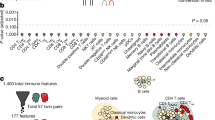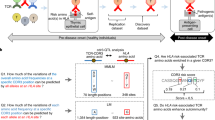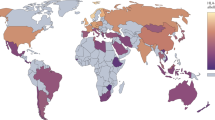Abstract
ALTHOUGH the cause of multiple sclerosis (MS) is unknown, it is thought to involve a T cell-mediated autoimmune mechanism. Susceptibility to the disease is influenced by genetic factors such as genes of the HLA and T-cell receptor (TCR) complex1–6. Other evidence for a genetic influence includes the low incidence in certain ethnic groups7, the increased risk if there are affected family members8 and the increased concordance rate for disease in monozygotic twin pairs (26%)9, compared to dizygotic twins. Epidemiological studies indicate that there may be an additional role for environmental factors. Although the target antigen(s) are not yet identified, several myelin or myelin-associated proteins have been suspected10–12, among them myelin basic protein. A lack of genetically comparable controls has impaired the analysis of the T-cell response in MS patients and caused disagreement on TCR usage in the disease13–15. Here we analyse the role of TCR genes in MS by comparing TCR usage in discordant versus concordant monozygotic twins in response to self and foreign antigens. We find that after stimulation with myelin basic protein or tetanus toxoid, control twin sets as well as concordant twin sets select similar Vα chains. Only the discordant twin sets select different TCRs after stimulation with antigens. Thus exogenous factors or the disease shape the TCR repertoire in MS patients, as seen by comparison with unaffected genetically identical individuals. This skewing of the TCR repertoire could contribute to the pathogenesis of MS and other T-cell-mediated diseases.
This is a preview of subscription content, access via your institution
Access options
Subscribe to this journal
Receive 51 print issues and online access
$199.00 per year
only $3.90 per issue
Buy this article
- Purchase on Springer Link
- Instant access to full article PDF
Prices may be subject to local taxes which are calculated during checkout
Similar content being viewed by others
References
Vartdal, F., Sollid, L. M., Vandvik, B., Markussen, G. & Thorsby, E. Hum. Immun. 25, 103–110 (1989).
Tiwari, J. L. & Terasaki, P. I. HLA and Disease Associations 152–167 (Springer, New York, 1985).
Cohen, D. et al. Proc. natn. Acad. Sci. U.S.A. 81, 1774–1778 (1984).
Olerup, O. et al. Proc. natn. Acad. Sci. U.S.A. 86, 7113–7117 (1989).
Beall, S. S. et al. J. Neuroimmun. 21, 59–66 (1989).
Seboun, E. et al. Cell 57, 1095–1100 (1989).
Waksman, B. H. & Reynolds, W. E. Proc. Soc. exp. Biol. Med. 175, 282–294 (1984).
Sadovnick, A. D., Baird, P. A. & Ward, R. H. Am. J. med. Genet. 29, 533–541 (1988).
Ebers, G. C. et al. New Engl. J. Med. 315, 1638–1642 (1986).
Johnson, D. et al. J. Neuroimmun. 13, 99–108 (1986).
Sun, J., Link, H., Olsson, T., Xiao, B-G. & Andersson, G. J. Immun. 146, 1490–1495 (1991).
Allegretta, M., Nicklas, J. A., Sriram, S. & Albertini, R. J. Science 247, 718–721 (1990).
Wucherpfennig, K. W. et al. Science 248, 1016–1019 (1990).
Kotzin, B. L. et al. Proc. natn. Acad. Sci. U.S.A. 88, 9161–9164 (1991).
Ben-Nun, A. et al. Proc. natn. Acad. Sci. U.S.A. 88, 2466–2470 (1991).
Gulwani-Alkolkar, B. et al. J. exp. Med. 174, 1139–1146 (1991).
Malhotra, U., Spielman, R. & Concannon, P. J. Immun. 149, 1802–1808 (1992).
Ota, K. et al. Nature 346, 183–187 (1990).
Chirgwin, J. M., Przybala, A. E., MacDonald, R. J. & Rutter, W. J. Biochemistry 18, 5294–5301 (1979).
Oksenberg, J. R. et al. Nature 345, 344–346 (1990).
Martin, R. et al. J. Immun. 148, 1359–1366 (1992).
Kurtzke, J. Neurology 33, 1444–1449 (1983).
Author information
Authors and Affiliations
Rights and permissions
About this article
Cite this article
Utz, U., Biddison, W., McFarland, H. et al. Skewed T-cell receptor repertoire in genetically identical twins correlates with multiple sclerosis. Nature 364, 243–247 (1993). https://doi.org/10.1038/364243a0
Received:
Accepted:
Issue Date:
DOI: https://doi.org/10.1038/364243a0
This article is cited by
-
Memory CD4+ T cell receptor repertoire data mining as a tool for identifying cytomegalovirus serostatus
Genes & Immunity (2019)
-
αβ T cell receptors as predictors of health and disease
Cellular & Molecular Immunology (2015)
-
Revisiting the T-cell receptor alpha/delta locus and possible associations with multiple sclerosis
Genes & Immunity (2011)
-
T cell receptor usage in autoimmune disease
Springer Seminars in Immunopathology (1999)
-
Diabetes induced by Coxsackie virus: Initiation by bystander damage and not molecular mimicry
Nature Medicine (1998)
Comments
By submitting a comment you agree to abide by our Terms and Community Guidelines. If you find something abusive or that does not comply with our terms or guidelines please flag it as inappropriate.



